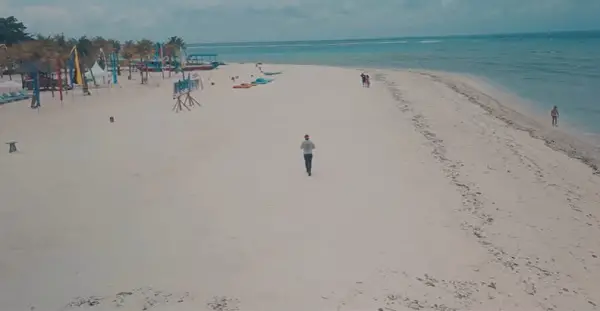
The beach is always a great spot to spend the day with family and friends, and it has some fantastic views that would look great if shot with a drone! But are you allowed to fly a drone at the beach? Here’s what I discovered.
The FAA does not have any laws that prohibit the flying of drones at beaches. However, there are various FAA rules and regulations you would still have to abide by when flying at the beach. Different cities and states also have different rules about drones on beaches, some even banning drones.
Keep reading to find out more about the laws you need to follow when flying a drone on the beach.
Laws To Watch Out For When Flying At The Beach
Even though the FAA (Federal Aviation Administration) has no laws that prevent enthusiasts from flying drones at beaches, it still requires you to follow the existing drone laws it has in place.
Law 01: Don’t Fly Over People
This is probably the most important law when flying your drone at the beach. It is an FAA law in the United States that you are not allowed to fly your drone directly over people.
While you might be looking forward to capturing stunning views from a popular beach on your drone, you can’t do this as drone flight over people is not promoted. The number of people does not matter either, this rule applies to fly over a single person or a group of people that are not part of the flight.
Popular beaches will usually have many people with families spending the day at the beach, in that case, you probably won’t be able to fly your drone unless you move away from people.
Law 02: Maintain Visual Line of Sight
When flying your drone at the beach, you might want to fly along the coastline or out to sea.
But there is a limitation to how far you can go. Put simply, the FAA has a rule put in place that doesn’t allow drone pilots to fly a drone further than where they can see it in plain sight.
The FAA states that a drone must always be flown within visual line of sight of the pilot or someone assisting the pilot as an observer.
So even though you might have a drone capable of flying miles away from its controller if you can’t see it, then you are breaching the FAA’s rules and regulations, and you could end up with a fine.
You can’t use a drones FPV (First Person View) camera or use any aids that assist in your vision such as telescopes or binoculars.
I’m sure you would have done this already before coming to the beach, but it is important to check the daily weather conditions because fog and clouds could impede your vision.
Law 03: Stay Below Maximum Allowable Altitude
The FAAs rules state that as a drone enthusiast, you must always fly your drone at or below 400 feet.
This rule was put in place in order to prevent potential collisions between drones and manned aircraft such as airplanes and helicopters.
These rules are different in every country and it is important for you to also check if you are looking at traveling, for example, the maximum height you are allowed to fly in Canada is 295 feet.
Law 04: Pay Attention To Community Based Guidelines
There are various levels of rules and regulations that all pilots have to be mindful of.
- National Law. The National laws are the various rules and regulations put together by the FAA for all pilots in the country to follow.
- State Law. The State laws are the different rules and regulations put together by the various States in order to regulate drones in that specific State.
- City Laws. Last but not least, you get City laws that are put together by the different cities within a state to control the use of drones in that City.
Each of these laws is important and must be followed if you want to fly legally and safely. This is also why it is important to do your research about the area you wish to fly in because the rules might be different in another area.
You can always find the information you need by looking for it on the internet or you could ask your local authority to make sure that you are abiding by the laws.
If you do your research and find that the area you are looking to fly in does not have any designated rules regarding drones, then you need to follow the rules set out by the country’s aviation authority, the FAA.
Law 05: Stay Away From Airports
As a drone pilot, you should know that flying anywhere within 5 miles of an airport is strictly prohibited by the FAA. Some airports are located really close to popular beaches and therefore flying a drone in that area is not allowed.
As a hobbyist drone pilot is possible to get permission to fly near an airport by requesting authorization via the LAANC (Low Altitude Authorization and Notification Capability) system.
IMPORTANT NOTE: Apply for LAANC approval before going to the beach if there is an airport within a 5-mile radius. To learn how I wrote a full guide on how to notify the airport of a drone flight as a hobbyist using LAANC here.
If you fly your drone at the beach that is located near an airport, the consequences are a lot harsher and you could end up with a large fine and even jail time.
This is another reason why it is important to do your research about the area you will be flying your drone to make sure you are not breaking any drone rules and regulations in the process.
3 Top Tips For Flying a Drone At The Beach
You might be someone who flies drones all the time, but I promise you flying a drone at the beach is a whole new ball game! The beach has more laws to consider, and it is filled with different terrain to maneuver around. Here are some tips for flying at the beach:
Tip 01: Don’t Fly Too Low or Too High
When flying at the beach, it is very important that you fly at the correct heights, and not too high or too low.
If you decide to fly too low your drone could crash land in the water, and you might need to get the fishing gear out.
Flying too high is something you shouldn’t be doing because it is illegal to fly over 400 feet.
This is also because the wind speeds are faster the higher you go, and this could disrupt your flight patterns causing you to crash. This is worse over the ocean!
Tip 02: Take Off & Land Away From The Sand
Another tip is that you should find a safe place to take off and to land. You shouldn’t take off or land on the sand.
In order for a drone to take off, it needs the propellers to spin and push air onto the ground which will then lift it up into the sky.
However, when sand is involved, this will only blow the sand around and as the drone is taking off or landing, the sand could fly up and hit the propellers.
This could cause the propellers to loosen and or damage them during this process. It could also cause you to crash your drone while trying to take off or land.
You could also have little sand particles lodge themselves into the open areas of the drone or the drone’s gimbal.
Tip 03: Vision and Infrared Sensing Systems Might Be Affected
DJI has stated that the performance of the Vision System and Infrared Sensing System are both affected by the surface they are flown over. This why drones with this technology tend to struggle over water and when flown near-transparent surfaces.
This is why it is always debated on whether or not you should turn VPS on or off when flying over water.
In my experience, if you will be flying less than 30 feet above the water, then you should turn it off as it will probably affect the drone’s flight.
But if you are flying over that then you shouldn’t have a problem, if you do have issues just fly higher or return the drone and turn your VPS off.
